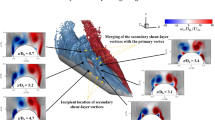Abstract
The dynamic responses of asymmetric vortices over a slender body to a rotating tip perturbation were investigated experimentally in a wind tunnel. A small rotating nose with an artificial micro-perturbation on the nose tip was driven by a servomotor with various rates to change azimuthal locations of tip perturbation. Wall pressures and spatial velocity fields were measured using pressure scanner and particle image velocimetry based on a phase-locked method. The results show that the spinning tip perturbation enables asymmetric vortices to exhibit significantly dynamic characteristics different from a case with a static perturbation. The orientations of asymmetric vortices and associated side forces show apparent phase delay that are enlarged with increasing rotational rates of the nose. The switching rates of asymmetric vortices among various orientations also increase with the rotational rates increasing, but asymmetry level of vortices is lowered, which reveals that the asymmetric vortices change requires an amount of time to switch from one orientation to another. The phase delays of vortices, however, are determined by the amount of time required for the propagation of disturbance waves along a body axis. As the rotational frequencies are sufficiently high, the orientations of vortices almost hold to be unchanged. The unchanged orientation of vortices is asymmetric, depending on the directions of rotation. The asymmetric vortices arising from high-frequency rotation of the nose are attributed to wall effects induced by the rotating nose with a finite length. In addition, there exist small intrinsic vortex oscillations which are superimposed on the average vortex structures with symmetric and asymmetric orientations for the cases of static and rotational tip perturbations.




















Similar content being viewed by others
References
Batchelor GK (1967) An introduction to fluid dynamics. Cambridge University Press, Cambridge, pp 340–343
Bernhardt JE, Williams DR (1998) Proportional control of asymmetric forebody vortices. AIAA J 36:2087–2093
Bridges DH, Hornung HG (1994) Elliptic tip effects on the vortex wake of an axisymmetric body at incidence. AIAA J 32:1437–1445
Chen XR, Deng XY, Wang YK, Liu PQ, Gu ZF (2002) Influence of nose perturbations on behaviors of asymmetric vortices over slender body. Acta Mech Sin 18:581–593
Degani D, Schiff LB (1991) Numerical simulation of the effect of spatial disturbances on vortex asymmetry. AIAA J 29:344–352
Degani D, Tobak M (1992) Experimental study of controlled tip disturbance effect on flow asymmetry. Phys Fluids 4:2825–2832
Deng XY, Zhang J, Ma BF, Wang YK (2011) Active control of perturbation of wing-body rock induced by forebody asymmetric vortices. AIP Conf Proc 1376:143–145
Ericsson LE (1988) Moving wall effects in unsteady flow. J Aircraft 25:977–990
Fidler J (1981) Active control of asymmetric vortex effects. J Aircr 18:267–272
Grandemange M, Gohlke M, Parezanović V, Cadot O (2012) On experimental sensitivity analysis of the turbulent wake from an axisymmetric blunt trailing edge. Phys Fluids 24:035106.1–035106.16
Grandemange M, Gohlke M, Cadot O (2013) Turbulent wake past a three-dimensional blunt body. Part 1. Global modes and bi-stability. J Fluid Mech 722:51–84
Grandemange M, Gohlke M, Cadot O (2014) Turbulent wake past a three-dimensional blunt body. Part 11. Experimental sensitivity analysis. J Fluid Mech 752:439–469
Lamont PJ (1982) Pressures around an inclined ogive cylinder with laminar, transitional, or turbulent separation. AIAA J 20:1492–1499
Levy Y, Hesselink L, Degani D (1996) Systematic study of the correlation between geometrical disturbances and flow asymmetries. AIAA J 34:772–777
Liu F, Luo S, Gao C, Meng X, Hao J, Wang J, Zhao Z (2008) Flow control over a conical forebody using duty-cycled plasma actuators. AIAA J 46:2969–2973
Ma BF, Liu TX (2014) Low-frequency vortex oscillation around slender bodies at high angles-of-attack. Phys Fluids 26:091701.1–091701.7
Ma BF, Deng XY, Chen Y (2007) Effects of forced asymmetric transition on vortex asymmetry around slender bodies. AIAA J 45:2671–2676
Ma BF, Huang Y, Liu TX (2014) Low frequency unsteadiness of vortex wakes over slender bodies at high angle of attack. Chin J Aeronaut 27:772–780
Ma BF, Deng XY, Rong Z, Wang B (2015) The self-excited rolling oscillations induced by fore-body vortices. Aerosp Sci Technol 47:299–313
Maynes RD, Gebert GA (1995) Rotating nose tip effects on slender body aerodynamics at high angles of attack. J Spacecr Rockets 32:944–950
Ming X, Gu YS (2006) Control of asymmetric flow fields of slender bodies at high angle of attack. Chin J Aeronaut 19:168–174
Modi VJ, Stewartf AC (1992) Approach to side force alleviation through modification of the pointed forebody geometry. J Aircr 29:123–130
Moskovitz CA, Hall RM, Dejarnette FR (1989) Effects of nose bluntness, roughness and surface perturbations on the asymmetric flow past slender bodies at large angles of attack. AIAA paper 89-2236-CP, 1989
Ng TT, Suarez CJ, Kramer BR, Ong LY, Ayers B, Malcolm GN (1994) Forebody vortex control for wing rock suppression. J Aircr 31:298–305
Porter C, Fagley C, Farnsworth J, Seidel J, McLaughlin T (2014) Closed-loop flow control of a forebody at a high incidence angle. AIAA J 52:1430–1440
Roshko A (1961) Experiments on the flow past a circular cylinder at very high reynolds number. J Fluid Mech 10:345–356
Schmid PJ, Henningson DS (2001) Stability and transition in shear flows. Springer, Berlin, p 337
Zhu YD, Yuan HJ, Lee CB (2015) Experimental investigations of the initial growth of flow asymmetries over a slender body of revolution at high angles of attack. Phys Fluids 27:084103.1–084103.13
Zilliac GG, Degani D, Tobak M (1991) Asymmetric vortices on a slender body of revolution. AIAA J 29:667–675
Acknowledgments
The project was supported by the National Natural Science Foundation of China (NSFC) under Grant No. 11272033. The authors also thank the anonymous reviewer for suggesting to add Fig. 7b and the results on dynamics of vortices, which is very helpful to improve the quality of the paper.
Author information
Authors and Affiliations
Corresponding author
Ethics declarations
Conflict of interest
The authors declare that they have no conflict of interest.
Rights and permissions
About this article
Cite this article
Ma, BF., Huang, Y. & Deng, XY. Dynamic responses of asymmetric vortices over slender bodies to a rotating tip perturbation. Exp Fluids 57, 54 (2016). https://doi.org/10.1007/s00348-016-2139-3
Received:
Revised:
Accepted:
Published:
DOI: https://doi.org/10.1007/s00348-016-2139-3




